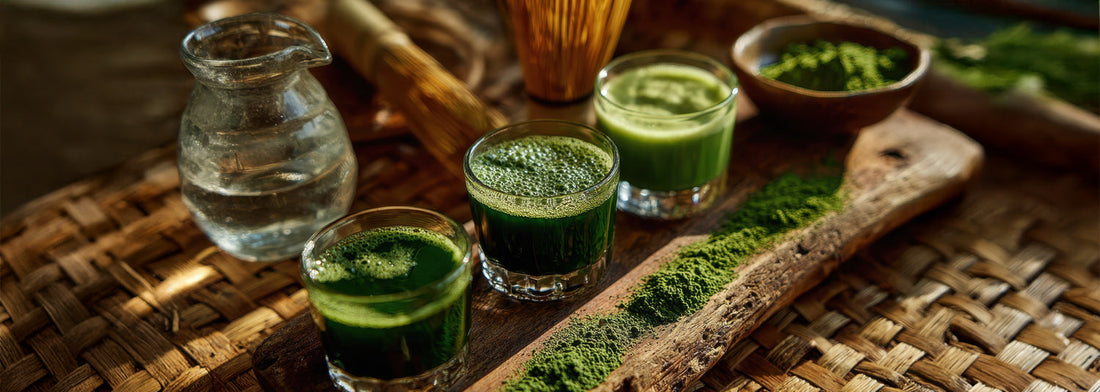
Matcha vs Wheatgrass: Which Superfood is Better?
Share
In the colourful world of superfoods, matcha and wheatgrass are two of the most vibrant and nutrient-packed contenders. Both deliver impressive health benefits backed by centuries of traditional use and modern research, but if you had to pick one, which would deserve the top spot?
Let’s explore their differences, their unique benefits, and why so many people are making fresh wheatgrass juice shots a daily habit.
What is Matcha?
Matcha is a finely ground green tea powder that originated in Japan, where it has been used in tea ceremonies for hundreds of years. Unlike regular green tea, where the leaves are steeped and discarded, matcha involves consuming the whole leaf, giving you a concentrated source of nutrients and antioxidants.
Benefits of Matcha
-
High in antioxidants – Particularly catechins like EGCG, which research has shown may help reduce inflammation and support cardiovascular health.
-
Supports focus and calm – L-theanine, an amino acid unique to tea plants, promotes relaxed alertness.
-
Provides a gentle caffeine boost – Around 70mg per cup for steady energy without the jitters.
-
May aid fat oxidation – Some studies suggest matcha can enhance fat burning during exercise.
Matcha is a versatile ingredient, enjoyed in teas, smoothies, and lattes and in our Elixir Vitality superfood Juice, where it’s paired with nutrient-rich pomegranate, aloe vera, and goji berries for a synergistic antioxidant blend.
What is Wheatgrass?
Wheatgrass is the young grass of the wheat plant, harvested before the grain forms, making it naturally gluten-free. Rich in vitamins A, C, E, and K, iron, magnesium, amino acids, and the green pigment chlorophyll, wheatgrass has been hailed as a nutritional powerhouse.
Research has shown that wheatgrass may support detoxification, antioxidant defences, and even help reduce oxidative damage in chronic disease.
At Britt’s Superfoods, we juice and freeze our traditionally grown wheatgrass soon after harvest, preserving its live enzymes and delicate phytonutrients for true farm-to-glass freshness.
Benefits of Wheatgrass Juice
-
Hair & Skin – Antioxidants and chlorophyll help reduce oxidative stress, which can promote healthy hair growth and radiant skin.
-
Weight Loss – Nutrient-dense yet low in calories, it may support metabolism and appetite control.
-
Cholesterol – Animal and human studies suggest wheatgrass can lower LDL (“bad”) cholesterol while raising HDL (“good”) cholesterol.
-
Diabetes – May help regulate blood sugar through its magnesium and antioxidant content.
-
Gut Health – Rich in enzymes and chlorophyll, it supports digestion and helps maintain healthy gut flora.
Which is Better for Energy, Matcha or Wheatgrass?
If you need a quick lift, matcha’s caffeine and L-theanine provide calm, focused alertness without the crash often linked to coffee.
Wheatgrass is caffeine-free, with energy coming from pure nutrition. Its chlorophyll and mineral content help oxygenate the blood, support adrenal health, and promote steady, natural vitality throughout the day.
Matcha wins for short-term mental focus. Wheatgrass takes the lead for sustained, crash-free energy.
Improve Gut Health Naturally
Gut health is central to overall wellness, and both matcha and wheatgrass can play a role.
-
Matcha contains polyphenols and mild anti-inflammatory compounds that may help support a healthy gut microbiome.
-
Wheatgrass is alkaline-forming, enzyme-rich, and high in chlorophyll — factors that can improve digestion, reduce acidity, and support beneficial gut bacteria.
For those dealing with bloating, sluggish digestion, or discomfort, a daily fresh wheatgrass juice shot can act as a gentle but effective reset for the digestive system.
Matcha vs Wheatgrass: Nutritional Facts
| Nutrient / Benefit | Matcha | Wheatgrass Juice |
|---|---|---|
| Antioxidants | High (catechins) | High (chlorophyll & flavonoids) |
| Caffeine | ~70mg per cup | None |
| Vitamins | Vitamin C, A, E, K | Vitamin A, C, E, K, B-complex |
| Minerals | Potassium, magnesium | Iron, calcium, magnesium |
| Detox Support | Mild | Strong (due to chlorophyll) |
| Energy Boost | Steady (caffeine + L-theanine) | Natural, caffeine-free |
Fresh Green Juice vs Green Powder
Fresh ingredients are the key to maximum nutrition. Live enzymes, delicate vitamins, and potent antioxidants begin breaking down the moment plants are harvested. Preserving them in their most natural form is crucial for optimal absorption.
Matcha Powder – Naturally consumed as a powder, made by stone-grinding shade-grown tea leaves. At Britt’s Superfoods, we use only the highest quality fresh matcha in our superfood juice shots, then freeze them immediately to lock in all the antioxidants and nutrients.
Fresh Wheatgrass Juice – Powdered wheatgrass is made by drying the grass or juice before grinding. This can reduce vitamin content and destroy fragile enzymes. Our frozen wheatgrass shots, however, preserve up to 28% more antioxidants, 48% more chlorophyll, and over 80 live enzymes compared to non-fresh, tray-grown alternatives.
Both matcha and wheatgrass are outstanding superfoods. Matcha offers calm, focused energy and antioxidant power, while wheatgrass delivers broad-spectrum benefits for hair, skin, digestion, cholesterol, weight loss, and more, all without caffeine.
If you want a mental boost, matcha is a great option. For comprehensive wellness and long-lasting natural vitality, fresh wheatgrass juice shots are hard to beat — especially when frozen straight after juicing to preserve peak nutritional value.
Matcha also works beautifully in blends. In our Elixir Vitality Juice, we pair premium fresh matcha with pomegranate, aloe vera, and goji berries for a synergistic combination that amplifies the nutritional benefits in every sip.

